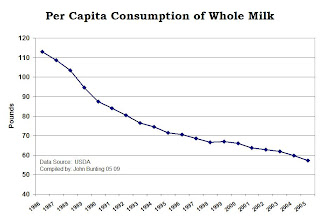
(click to enlarge)
Not following conventional thinking entails taking certain risk, not the least of which is the accusation of believing in conspiracy theories. However, most conventional thinking will not stand up to careful observation.
Economics professor Emmanuel Saez of UCLA, Berkeley has done some very interesting work on economic distribution as seen from the above graph. Professors Saez has examined income taxed data from 1917 through 2006.
Most interesting about the work of professor Saez is, that income distribution information shows the way the pie is sliced has much to do with government policy.
The amount of income going to the top 10% from post-World War II until about 1980 corresponds with what might be considered by many to be the golden age of farming.
For dairy, parity was created by government in the late 1940s and taken away in 1981. The excuse for taking away parity was to reduce farm milk production, and that of course did not happen. Farm milk simply became cheaper to buy. Farm income per cow was vastly reduced. Farm consolidation occurred as an attempt to keep the dairy farmer’s nose above water.
The moral of this tale is that a change in attitude is the mandatory first step in correcting the broken farm milk pricing system.






